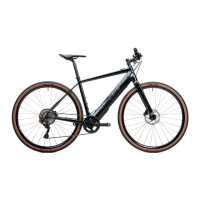and your bicycle may be dicult to control due to improper geometry that results from
the modication.
IMPORTANT: make sure your wheels function properly before each use, check if the
mounting bolts are secure, check that the freewheel engages correctly. If there is any
malfunction of the hubs, they should not be used under any condition. In case of any
doubt, consult an experienced bike mechanic.
BRAKES
There are two main types of bicycle brakes: rim brakes, operated by squeezing the
wheel rim between two brake pads and disc brakes, operated by squeezing a hub
mounted disc between two brake pads. Both can be actuated by the rider squeezing a
lever mounted on the handlebar.
WARNING: Riding with brakes that have not been adjusted properly, worn brake pads,
or wheels with a visible rim wear marks constitutes a hazard and can cause serious
injury or death. Too hard or too sudden application of the brakes can cause the wheel
to lock up and make you lose control and fall. Applying the front brake too suddenly or
excessively may result in the rider’s pitching over the handlebars, potentially causing se-
rious injury or death. Bicycle brakes may be very powerful, especially disc brakes or lin-
ear-pull brakes. You should be extra careful while learning how to operate such brakes
and take particular care while using them. Disc brakes can heat up extremely when their
application is prolonged. Disc brake rotors can get very hot even with little use, so don’t
touch a disc brake rotor until it has had plenty of time to cool. Remember that brake
pads in all brake types will wear out, which will ultimately reduce their eciency. For
information on how to operate and maintain your brakes and when to replace the brake
pads see the brake manufacturer’s operation and maintenance manual. If you have
not been provided with the manufacturer’s instruction manual, contact your dealer or
the brake manufacturer. When replacing worn or damaged parts the manufacturer-ap-
proved genuine spare parts are to be used only.
It’s vital for your safety to learn and remember which brake is controlled by which
brake lever on your bike. Acquaint yourself with the setup of your brakes by alternately
squeezing the left and right brake lever and observing which brake lever activates the
front brake, and which one activates the rear brake. You should be able to reach the
brake levers with your hands and squeeze them easily. If you nd out that your hands
are too small to do so, you should consult it with your dealer before riding the bike. In
some models the lever reach may be adjusted, or you may need a dierent brake lever
design.
OPERATION OF THE BRAKING SYSTEM
The bicycle braking system’s function is based on friction between two braking surfaces.
To assure its proper functioning you should maintain the rims, brake pads, disc rotor
and calliper clean and free of dust, dirt, grease, lubricants, waxes and polishes. There

